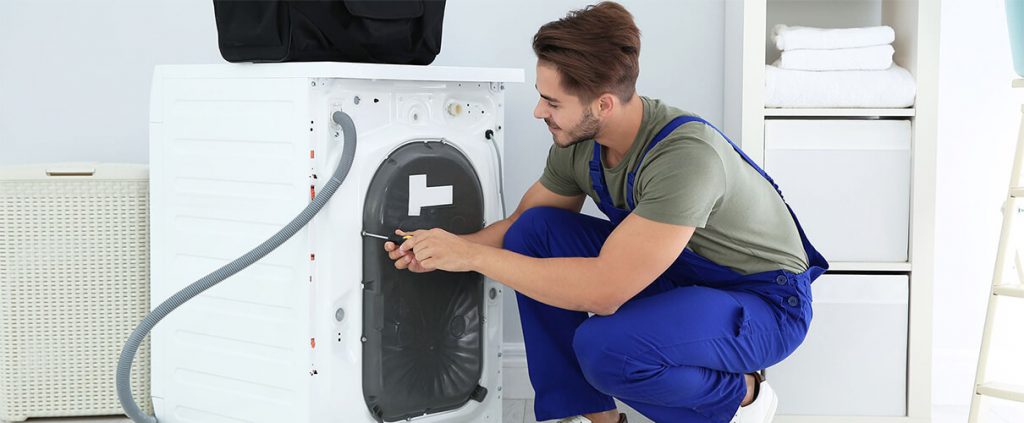7 Easy Tips for Dryer Fire Safety

Dryer fire safety is a critical aspect of home maintenance that should never be overlooked. While dryers provide convenience and efficiency in laundry care, they can pose significant fire hazards if not properly maintained. Understanding the importance of dryer fire safety and the potential risks involved is crucial for ensuring the well-being of your home and family.
The potential risks involved in dryer fires are alarming. They can quickly spread throughout the house, causing significant property damage and putting lives at risk. The high temperatures generated by the dryer can ignite nearby flammable materials, leading to rapid fire growth.
We will explore unconventional tips and techniques that can enhance dryer fire safety, offering you peace of mind and a safer laundry experience.
Causes of Dryer Fire
Dryer fires can occur due to various factors, with one of the primary causes being the accumulation of lint. As clothes tumble and dry, lint particles accumulate in the lint trap, vent hose, and exhaust ducts. If not cleaned regularly, this lint buildup becomes highly flammable and can ignite, leading to a devastating fire. Here are some other causes to look out for that can possibly be the reason for dryer fire hazards in your home:
1. Lint Accumulation
One of the leading causes of dryer fires is the buildup of lint in various components of the dryer, including the lint trap, vent hose, and exhaust ducts. Over time, lint accumulates and restricts airflow, increasing the risk of overheating and ignition.
2. Improper Ventilation
Inadequate ventilation or improper installation of the dryer’s exhaust system can impede the proper flow of air, leading to overheating and potential fire hazards. It is crucial to ensure that the dryer is vented correctly to the outdoors and that the ventilation system is clean and free from obstructions.
3. Flammable Materials
Placing flammable items such as clothing with flammable stains, rubber-backed rugs, or materials like foam or plastic in the dryer can increase the risk of a fire. These materials can ignite easily under high temperatures, leading to a dangerous situation.
4. Overloading the Dryer
Overloading the dryer with an excessive amount of clothes can hinder proper airflow and increase the likelihood of lint accumulation. Insufficient space between garments can also prevent efficient drying, causing overheating and potential fire hazards.
5. Lack of Maintenance
Neglecting regular maintenance tasks such as cleaning the lint trap, vent, and exhaust ducts can contribute to lint buildup and reduce the dryer’s efficiency. Without proper maintenance, the risk of fire increases significantly.
6. Malfunctioning Components
Faulty or malfunctioning components within the dryer, such as heating elements, thermostats, or electrical wiring, can lead to overheating and potential fire incidents. Regular inspection and timely repair or replacement of faulty parts are essential to ensure safe dryer operation.
Easy Tips for Dryer Fire Safety at Home
By prioritizing dryer fire safety, you can minimize the risk of fire-related incidents, protect your property, and ensure the safety of your loved ones. Taking preventive measures and implementing safety practices will go a long way in mitigating the potential dangers associated with dryer fires. Here are some tips for effective dryer safety you can practice at home:
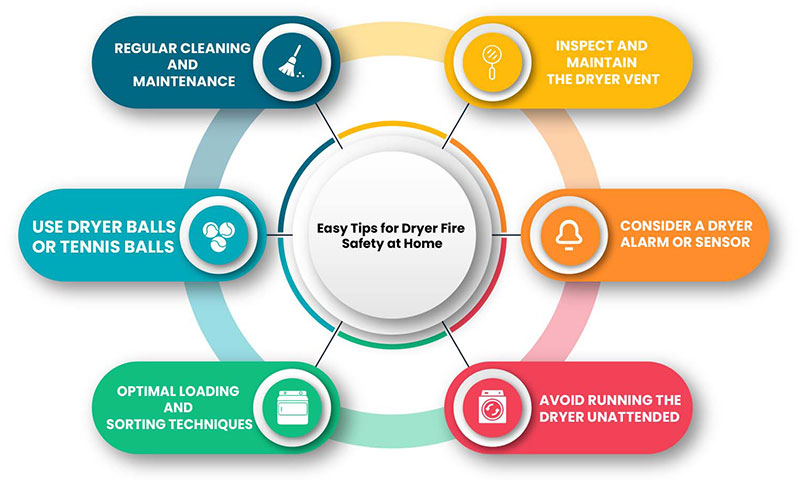
Tip 1: Regular Cleaning and Maintenance
- Clean the lint trap or filter before or after each use. This helps prevent lint buildup, which can restrict airflow and increase fire risks.
- Remove accumulated lint by hand or with a soft brush. Ensure you remove all lint to maintain optimal airflow and prevent potential fire hazards.
- Clogged lint traps restrict airflow, so it’s important to clean them regularly. A clear lint trap allows for proper ventilation and reduces the risk of dryer fires.
- Disconnect the vent hose from the dryer and clean any lint or debris that may have accumulated. Use a vent brush or a vacuum attachment to thoroughly clean the vent and duct.
- Regular cleaning and maintenance of your dryer’s lint trap, vent, and exhaust duct are essential for dryer fire safety. Proper airflow promotes safe operation and minimizes fire risks.
Tip 2: Use Dryer Balls or Tennis Balls
Using dryer balls or tennis balls in your dryer can help improve airflow and reduce the risk of dryer fires. Here’s how:
- Add a few dryer balls or tennis balls to your dryer along with your laundry. These balls help to separate and fluff the clothes, allowing for better airflow during the drying process.
- The bouncing motion of the balls helps to break up clumps of wet laundry, reducing drying time and preventing overheating.
- By reducing drying time, using dryer balls or tennis balls can also save energy and reduce utility costs.
- Dryer balls are typically made of wool or plastic, while tennis balls are made of rubber. Both options are effective in improving drying efficiency and reducing the risk of fires.
Remember to check the condition of the dryer balls or tennis balls regularly. If they become damaged or worn out, replace them to maintain their effectiveness.
Tip 3: Optimal Loading and Sorting Techniques
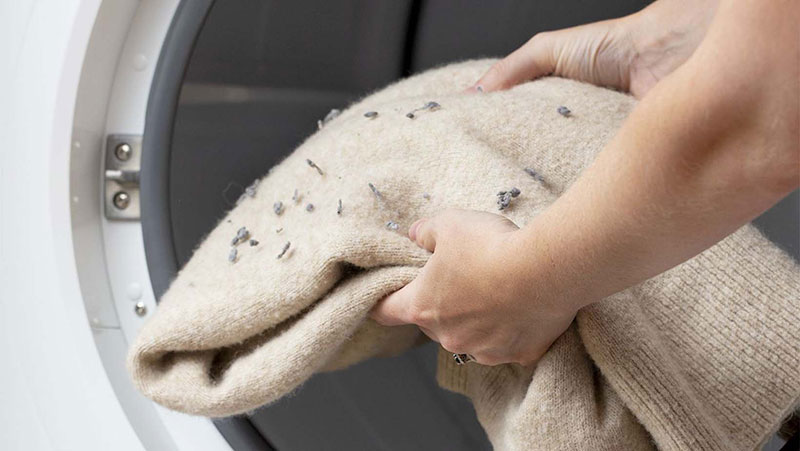
Proper loading and sorting of laundry in the dryer can contribute to dryer fire safety. Follow these tips to ensure optimal loading and sorting:
- Avoid overloading the dryer. Overloading restricts airflow and can lead to overheating. Leave enough space for the clothes to move freely and allow air to circulate.
- Separate items by fabric type and weight. Heavy items like towels or jeans should be dried separately from lighter fabrics like shirts or delicate garments. This prevents uneven drying and reduces the risk of overheating.
- Remove any flammable items from the load. Items such as cleaning rags, foam rubber, or clothing with flammable substances can ignite under high heat. Keep these items away from the dryer to minimize the risk of fire.
- Clean the lint filter before every load. A clogged lint filter obstructs airflow and increases the chance of lint buildup in the dryer vent, which is a common cause of dryer fires. Regularly removing lint from the filter helps maintain proper airflow and reduces fire risks.
- Check and clean the dryer vent regularly. Clear any lint buildup or obstructions from the dryer vent, including the vent hose or duct. A clean vent allows for efficient airflow and reduces the likelihood of dryer fires.
Tip 4: Inspect and Maintain the Dryer Vent
Follow these points to keep your dryer vent in optimal condition:
- Check the exterior vent hood for any obstructions or debris. Clear away any lint, dust, or other materials that may be blocking the vent opening. This allows for proper airflow and reduces the risk of overheating.
- Inspect the vent hose for any damage, such as cracks, holes, or disconnections. Damaged vent hoses can lead to lint buildup or leakage, increasing the risk of fire. Replace any damaged parts promptly.
- Ensure that the vent hose is properly connected and secured to both the dryer and the exterior vent. Loose connections can cause airflow restrictions and potential fire hazards.
- Regularly remove any lint or debris that may have accumulated inside the dryer vent. Use a vent brush or a vacuum attachment to thoroughly clean the vent and remove any blockages.
- Consider professional dryer vent cleaning at least once a year. A professional service will thoroughly clean the vent system, ensuring optimal airflow and reducing the risk of dryer fires.
Tip 5: Inspect and Maintain the Dryer Vent
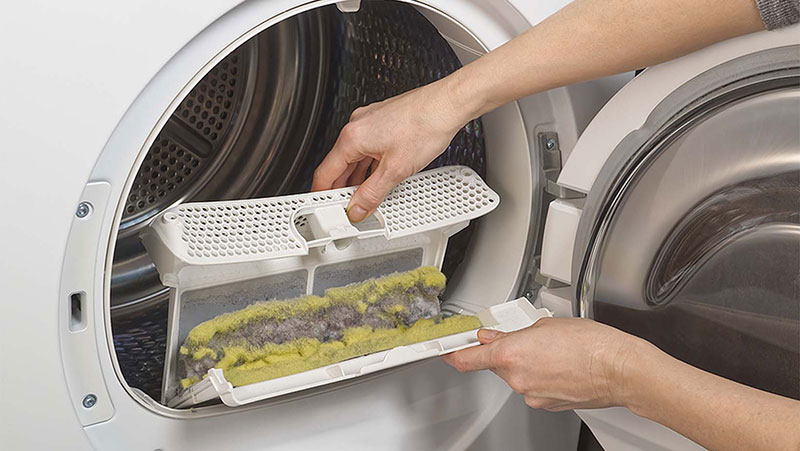
These devices can provide an added layer of protection and alert you to potential hazards. Here are some key points to consider:
- Regularly inspect the dryer vent for any blockages or obstructions. Remove lint buildup and debris to ensure proper airflow.
- Check for any signs of damage or wear in the vent, such as cracks or disconnections. Repair or replace any damaged sections promptly.
- Keep the area around the dryer vent clean and free from clutter to prevent airflow restrictions.
- Schedule professional dryer vent cleaning at least once a year to ensure thorough removal of lint and debris.
- Consider using a vent cover or screen to prevent birds or pests from entering the vent and causing blockages.
- Properly maintain the exhaust hood or cap outside your home, ensuring it opens and closes freely and is in good condition.
Tip 6: Consider a Dryer Alarm or Sensor
To enhance dryer fire safety, consider installing a dryer alarm or sensor. Here’s why it’s beneficial:
- Enhance your dryer fire safety by installing a dryer alarm or sensor.
- These devices provide an additional layer of protection and early detection of potential issues.
- Dryer alarms or sensors can alert you to overheating, excessive lint buildup, or other dryer malfunctions.
- They are easy to install, affordable, and compatible with most dryer models.
- Investing in a reliable dryer alarm or sensor adds peace of mind and helps prevent dryer fires.
Tip 7: Avoid Running the Dryer Unattended
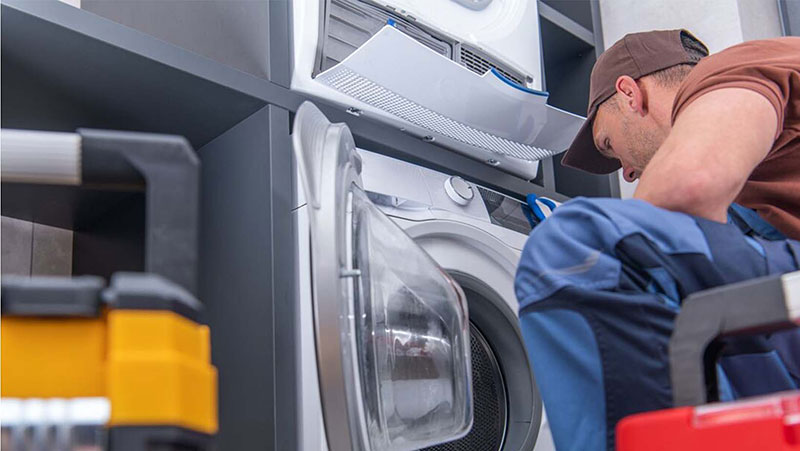
It’s essential to avoid running the dryer unattended. Follow these guidelines:
- Whenever possible, avoid leaving the house or going to bed while the dryer is running. This allows you to promptly address any issues that may arise.
- While drying clothes, stay in the vicinity and periodically check on the dryer to ensure everything is running smoothly.
- Avoid starting the dryer before leaving the house, as you won’t be able to monitor it.
- If you need to step away briefly, pause the dryer and resume once you return.
- Promptly remove clothes from the dryer as soon as the cycle is complete to prevent overheating and reduce the risk of fire.
- Regularly check the dryer’s power cord for any signs of damage, such as fraying or exposed wires. If you notice any issues, discontinue use and have it repaired or replaced by a professional.
Finding Dryer Repair Services Near Me
When you need dryer repair services in New York or New Jersey, Appliance Medic appliance repair services are here to help. As a trusted appliance repair company, we specialize in repairing a wide range of appliances, including washing machine dryers. Our team of skilled technicians is experienced in diagnosing and fixing various dryer issues efficiently and effectively.
Our technicians stay up to date with the latest industry advancements and undergo regular training to ensure they are well-equipped to handle any dryer repair. With our convenient locations in Rockland County, New York, and Passiac County, New Jersey, we are easily accessible to residents in these areas.
Call us at 845-617-1111 or 201-589-2399 or fill out the inquiry form to schedule an appointment and have your dryer repaired by our experienced technicians. We are dedicated to delivering top-notch service and ensuring your complete satisfaction with every repair we undertake.



